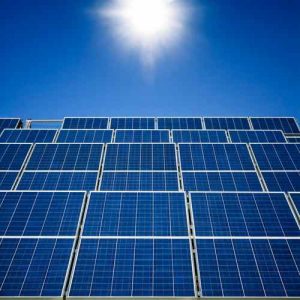Rooftop Solar in Bangalore – Feasibility and Financing
In our previous post, we gave you basic information on how to think about purchasing, installing and financing a rooftop solar system, including cost-benefit analysis.
Today, we’ll take a deep-dive into the economics of rooftop solar systems in Bangalore, Karnataka. Karnataka is a pioneer state for on-grid rooftop solar. With innovative policies, it was responsible for a huge surge in interest from all sections of society to install rooftop solar plants.
For technical and economic reasons, rooftop solar policy makers prefer to target “prosumers” i.e., consumers of electricity who wish to also produce electricity in amounts comparable to their consumption. Due to the erstwhile lucrative policy wording, a large number of applicants for large rooftop solar plants were found to be minor consumers of electricity. For instance, agriculturalists lined up to set up large “rooftop” plants on open land by constructing a shed. This went against the spirit of the rooftop policy, and rooftop solar electricity producers started looking very much like ground-mounted solar producers (which come under a different policy and have lower buyback rates for sound reasons) A mid-course policy correction was thus inevitable and KERC announced the new rooftop solar tariff and rules in May 2016.
Salient changes in Karnataka rooftop solar policy 2016
- Maximum size of solar plant limited to 150% of sanctioned load / contract demand: This is still liberal compared to other states that limit the plant size to the sanctioned load or less.
- For residential, educational institutions and hospitals, net metering is no longer applicable. These prosumers will be instead compensated via gross metering: The justification for this shift was that many consumers felt shortchanged by net metering (since consumer electricity tariffs are lower than the solar purchase tariffs) and wished a uniform buyback rate for all the electricity they produced.
- Capacity based buyback tariffs: Whereas earlier all consumers got ₹9.56 for every excess unit of electricity generated, new plants will be compensated as per the following tariffs:
| Capacity of Solar Rooftop and small PV power plants | Approved Tariff in ₹/Unit (Without Capital Subsidy) | Approved Tariff in ₹/Unit (With Capital Subsidy of 15%) |
| 1 to 10kW | 7.08 | 6.03 |
| Above 10kW and upto 50kW | 6.61 | 5.63 |
| Above 50kW and upto 100kW. | 6.14 | 5.23 |
| Above 100kW and upto 500kW | 5.67 | 4.83 |
| Above 500kW and upto 1MW | 5.20 | 4.43 |
These rates are fixed for the duration of the 25 year Power Purchase Agreement (PPA).
This tariff schedule effectively removes any advantage larger system owners had due to economics of scale, and also ensures the overall financial benefit per unit for subsidized and unsubsidized systems is the same. Also, no subsidy has been disbursed by the state nodal agency KREDL as per our knowledge. We therefore recommend not to pursue the subsidy option.
Sizing considerations
From the above policy, Oorjan recommends the following sizing for your rooftop solar project if you are a residential, educational institution or hospital consumer. You should go with the maximum sized rooftop solar system possible, subject to:
- 150% of your sanctioned load (Your sanctioned load is mentioned in kW on your electricity bill)
- Available roof area: 1 kW requires approximately 100 sq ft of shade free rooftop space.
- If the kW value calculated from 1 and 2 above is close to a capacity tariff tier, round it down to the maximum capacity.
Sample calculation: If your sanctioned load is 10kW, you should consider a system size of 10 * 150% = 15kW. This requires 1500 sq ft roof space. However, if you have only 1100 sq ft space available, the size gets limited to 11kW. Since the tariff changes at 10kW, a 10kW system would be best for you.
Returns Calculation
How much would investing in a 10kW rooftop solar system return on purely financial terms? A 10kW system will generate on average 1250 units of electricity every month. The earnings from selling this energy to the discom (BESCOM / MESCOM / HESCOM / GESCOM / CESCOM) are ₹8,850 per month. Assuming a turnkey project cost of ₹7.72 lakh, this would imply a simple annual return on investment (ROI) of 13.8%, which is quite attractive.
To be conservative, we further assume the following:
- Panel output degradation of 1% per year
- Maintenance / wear and tear budget of ₹750 per month with inflation at 3% per year
- Zero salvage value at the end of the PPA
The internal rate of return (IRR) of the rooftop solar system now reduces to 10.8% per year. This is still a higher ROI than keeping your money in the bank or many other long term investment avenues! In addition, there are the non-financial benefits of going solar, such as contributing towards a greener and cleaner planet.
If you’re in Bangalore and have been thinking about going solar, get in touch with Oorjan (http://oorjan.com), India’s first rooftop solar financing platform. We can help you think through the specifics of your situation. If you already have a price proposal and project design from an installer, send it to us for evaluation and financing. If you are just getting started, we can help you choose a highly rated local installer and obtain financing. Loan approvals for EMI schemes typically take 2-3 weeks, while pay-per-unit agreements take upto 6 weeks. We also provide a user-friendly app to monitor system performance once your project is installed, and provide periodic alerts. Contact us if you have always wanted to go solar, have questions and/or money was in the way!
This post first appeared on this link
This post is a guest contribution by Oorjan Cleantech, a company that enables solar rooftop financing. It is an initiative by Alums of IIT Bombay having years of experience in Solar PhotoVoltaic Markets. They have an estimator and contact form on their website www.oorjan.com.
About the Author:
Abhishek Jain is an Alumnus of IIT Bombay with almost 10 years of experience in corporate before starting Bijli Bachao in 2012. His passion for solving problems moved him towards Energy Sector and he is keen to learn about customer behavior towards Energy and find ways to influence the same towards Sustainability. More from this author.





